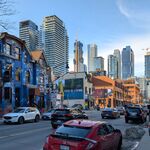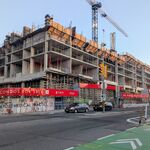Average price of single home in Toronto shoots up 13% to $965,000
Shortage of listings continues to plague market, drive high price growth. Leading the real estate pack in terms of price growth were semi-detached houses, with the average Toronto semi selling for $702,000.
Active listings were down 8.4 per cent, a persistent problem which has been driving significant price growth. This home on Dupont St. (at Ossington), with a unique coach house n back, sold for $1 million in April 2014.
Active listings were down 8.4 per cent, a persistent problem which has been driving significant price growth. This home on Dupont St. (at Ossington), with a unique coach house in back, sold for $1 million in April 2014.
By: Susan Pigg Business Reporter, Published on Tue May 06 2014
The average price of a detached home in the City of Toronto hit close to $1 million in April as the GTA continues to be plagued by a shortage of new listings.
That shortage of homes for sale helped pushed prices up an average of more than 10 per cent from April of 2013. The average sale price of a home across the GTA hit $577,898 last month, according to figures released Tuesday by the Toronto Real Estate Board.
Sales were up just 1.8 per cent, year over year.
Leading the real estate pack in terms of price growth were semi-detached houses. The average sale price across the GTA was up 11.6 per cent over April 2013. The 18 per cent jump in prices just in the City of Toronto sent the average sale price of a semi to $702,332, according to the TREB figures.
Next in line in terms of price spikes were detached homes where prices were up 11.3 per cent — 13.2 per cent in the City of Toronto, where the average sale price of a detached in April was $965,670.
Active listings, however, even for the first month of peak spring market, were down 8.4 per cent, a persistent problem which has been driving significant price growth, especially in 416 neighbourhoods close to the core and transit lines.
TREB president Dianne Usher blamed Toronto’s double land transfer tax for the fact more folks are choosing to stay put and renovate rather than sell.
As well, “above-trend home sales in the years leading up to the recession have meant that many households who purchased during this period simply aren’t ready to move again.â€
But also skewing the numbers is the desperation of buyers, frantic to get into the Toronto market before prices shoot further out of sight.
One, in North Toronto, reached a ludicrous new level in late April when 72 people — double the previous record for a bidding war frenzy for a house in the 416 region — registered offers on a Glencairn Ave. fixer upper.
Lawrence Park fixer-upper gets 72 offers
It went for $1.366 million. That was almost double the $699,000 list price, which the realtor acknowledged he deliberately underpriced by at least $400,000 “mainly to create buzz.â€
A decade ago the average detached house in the 416 region sold for just $486,489.
The April number pushes Toronto further into the stratosphere of Canada’s priciest real estate market, Vancouver. There the average detached sold for close to $1.2 million in April, a drop from the record $1.36 million the west-coast city recorded in February.
“Until we see a marked and sustained increase in listings, we should expect to see the annual rate of price growth above the long-term norm,†said Jason Mercer in a statement Tuesday, TREB’s senior manager of market analysis.
Sales of detached homes were up just 2.5 per cent across the GTA, with sale prices averaging $730,328 — an average of $645,179 in the 905 region.
Semi-detached homes across the GTA were down 5.4 per cent in April, year over year, but prices were up 18 per cent in the City of Toronto, to an average of $702,332. The average price of a 905 semi was up 8 per cent to $443,318.
Townhouse sales were down 8.3 per cent GTA-wide, but prices were up 14.7 per cent in Toronto to an average of $498,083. The 905 average sale price for a townhouse was $410,270, up 9.6 per cent.
Condo sales were up 3.2 per cent. That saw the average sale price in the 416 region come in just 1.8 per cent over last April, at $384,758. Resale condo prices in the 905 regions, however, were up 8.1 per cent to $296,078.
The MLS benchmark house price was up 7 per cent year over year. That indicator strips out fluctuations due to a sale of, say, more high-end homes in a month that could skew the sales figures.
















